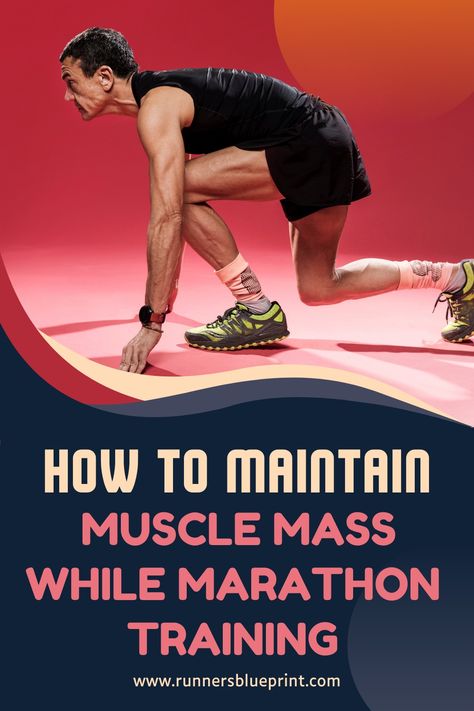Training for a marathon while trying to keep muscle can feel like a balancing act—trust me, I’ve been there!
When I jumped on the marathon training wagon, I was terrified of losing the muscle mass I had worked so hard to build.
It felt like I was being pulled in two directions—wanting to improve my endurance without sacrificing strength.
But through trial and error, I developed strategies that helped me maintain muscle while hitting my running goals
In this guide, I’ll share my tips on how to maintain muscle mass while training for a marathon—without sacrificing your running performance.
Building Muscle vs. Maintaining Muscle
Let’s talk about the difference between building and keeping muscle, especially when you’re also training for a marathon.
Building muscle is all about pushing your body to its limits. You lift heavier weights, challenge your muscles, and aim for growth by breaking them down so they rebuild stronger.
But maintaining muscle? That’s different. The aim here is to keep the muscle you have, not to bulk up. Just enough work to keep things from slipping.
Honestly, when you’re marathon training, keeping muscle is more realistic than trying to add more.
Long-distance running is not ideal for muscle growth, but with a smart approach, you can prevent muscle loss while focusing on your running goals.
Why Maintaining Muscle During Marathon Training is Tough
There’s a common myth that running burns muscle, but it’s a bit more complicated than that. Yes, endurance exercise can put you in a catabolic state, where your body breaks down muscle for fuel, but it’s not as severe as it sounds.
The real issue arises when your body doesn’t have enough fuel—like glycogen from carbs or fat. If you don’t fuel up, your body can start using muscle for energy on those long runs, which is the last thing you want.
Studies show that marathon runners often face muscle damage, especially the longer they go—something I definitely noticed after my first big race. So, it’s true that running can use some muscle for energy, but it’s avoidable if you fuel your body right.
How to Maintain Muscle While Training for a Marathon
Here’s how you can maintain your muscle mass and strength as you train for your marathon:
Fuel Up Properly
In my first month of marathon training, I felt drained after my long runs, and my recovery was taking forever. That’s when I realized that I wasn’t eating enough. I had been so focused on “staying lean” that I wasn’t giving my body the needed fuel.
Marathon training burns many calories, especially on long-run days, so you need to keep your energy stored up.
Carbs are your best friend here. They provide your muscles with glycogen, the fuel to power through long runs. Ensure you eat plenty of complex carbs like whole grains, vegetables, sweet potatoes, and fruits.
Timing matters, too. I started paying attention to how much I was eating—especially carbs. Before a long run, I’d have a solid meal like oatmeal with bananas or a bagel with peanut butter. After the run, I’d focus on refueling with a mix of carbs and protein—like a big bowl of pasta with chicken or a smoothie with protein powder and fruit.
For long runs (over 90 minutes), I aim to take in about 50g of carbs per hour. This could be in gels, sports drinks, or easily digestible snacks.
Once I got my nutrition sorted, my energy bounced back, and I wasn’t dragging after every run. I was even able to keep my gym sessions going strong!
Prioritize Protein
While carbs fuel your runs, protein is essential for muscle repair and maintenance. Protein supplies your body with the amino acids to repair muscle damage and maintain mass.
Protein gives your body the building blocks it needs to repair and keep muscle.. Not only you can’t build muscle without it, you won’t even be able to maintain it.
Don’t just take my word for it—there’s solid research backing this up
A study out of the International Society of Sports Nutrition (ISSN) reported that boosting protein intake from the daily suggested 0.8 per kilogram of body weight a day to 1.2 to 2 grams while reducing calories to about 30 40 percent can maximize fat loss while preserving existing muscle.
So how much should you be having?
I’d recommend having around 1.2 to 2 grams of protein per kilogram of body weight daily to maintain muscle. For a 160-pound runner, that’s around 100-145 grams of protein daily.
Some great sources of protein include:
- Eggs
- Lean meat (like chicken or turkey)
- Fish
- Greek yogurt
- Cottage cheese
- Beans and lentils
- Nuts and seeds
If you struggle to hit your protein goals through food alone, protein supplements like shakes or BCAAs (branched-chain amino acids) can be a helpful addition.
Strength Train Consistently
A mistake I made early in my marathon training was cutting back on my strength workouts because I felt like I “didn’t have time.” Big mistake.
My runs started feeling harder, and my muscles didn’t have the same power they used to.
I got back into a regular strength routine, doing a couple of days a week with squats, deadlifts, and pull-ups—just enough to keep my muscles active. I also added some core work to keep my body strong and stable during my runs.
I’d recommend lifting three to four times per week. Focus on compound movements that target large muscle groups, like squats, deadlifts, and bench presses. These exercises build strength and help maintain the muscle you’ve already built.
My routine looked something like this:
- Monday: Chest and back + easy run
- Wednesday: Legs and core + easy run
- Friday: Shoulders and arms
- Saturday: Long run
By keeping my strength sessions short but effective, I didn’t feel burnt out and could keep up with my running schedule.
Supplement Wisely
While your diet and training should be your primary focus, supplements can enhance muscle maintenance during marathon training.
BCAAs (branched-chain amino acids) are a great option. They provide your body with leucine, isoleucine, and valine—amino acids that help prevent muscle breakdown during long bouts of exercise. BCAAs turned out to be really helpful for recovery. I noticed less soreness after my long runs and faster recovery for my next gym session
I was skeptical about supplements at first. But after reading up on BCAAs (branched-chain amino acids) and their role in muscle recovery, I decided to give them a shot. I added a BCAA supplement to my water bottle during long runs and before my strength workouts.
I noticed that I wasn’t as sore after intense sessions, and I recovered quicker between runs and gym days. It wasn’t a magic pill, but it made a difference, especially when pushing myself harder as race day approached.
And there’s research to back it up! These three amino acids play a big role in recovery, especially for us endurance folks
Like any other source of protein, you can get BCCAs through your diet by eating quality protein foods. But supplements can help take your intake to the next level.
Don’t Forget to Rest and Recovery
Recovery is just as important as the training itself. Without enough rest, your body won’t have the time to repair muscle fibers and recover from the stress of marathon training.
Ensure you’re getting enough sleep each night—aim for 7-9 hours—and take at least one to two rest days per week. These days, focus on low-intensity activities like stretching, yoga, or swimming.
Listening to your body is key. If you feel overly tired, sore, or unmotivated, it might be time to dial back and allow for more recovery.
Balancing It All: Weekly Schedule Example
Here’s how a balanced week might look, combining running, strength, and cross-training:
- Monday: Easy run + lower body strength
- Tuesday: Rest or light cross-training (e.g., cycling)
- Wednesday: Tempo run or speed work + core and stability training
- Thursday: Easy recovery run
- Friday: Rest day or light cross-training (e.g., swimming or yoga)
- Saturday: Long run
- Sunday: Full-body strength workout
Weekly Strength Training Routine for Marathon Runners
Strength training regularly helps build a strong foundation for endurance, stability, and injury prevention. Here’s a simple, effective plan with two weekly sessions designed to complement your running and avoid over-fatiguing your muscles. This routine focuses on compound movements that engage multiple muscle groups for efficient, full-body conditioning.
Weekly Strength Plan: Compound Movements for Runners
Session 1 (Monday or Tuesday): Lower Body and Core Stability
Focus: Building glute, leg, and core strength for stability on long runs.
- Squats – 3 sets of 10–12 reps
Targets: Quads, glutes, hamstrings
- Coach’s Tip: Keep your chest up and push through your heels to engage your glutes and core.
- Walking Lunges – 3 sets of 10 reps per leg
Targets: Quads, glutes, balance
- Coach’s Tip: Take a controlled step forward, keeping your knee aligned with your ankle, to build strength and stability.
- Glute Bridges – 3 sets of 15 reps
Targets: Glutes, hamstrings
- Coach’s Tip: Squeeze your glutes at the top of each rep and avoid arching your back to protect your lower spine.
- Plank Hold – 3 sets of 30–45 seconds
Targets: Core stability, shoulders
- Coach’s Tip: Engage your core and keep your body in a straight line. Planks are great for core stability, which helps maintain good form on long runs.
Session 2 (Thursday or Friday): Full-Body Strength and Power
Focus: Enhancing overall strength and power with movements that support strong, stable strides.
- Deadlifts – 3 sets of 8–10 reps (use dumbbells or a barbell)
Targets: Hamstrings, glutes, lower back
- Coach’s Tip: Keep your spine neutral and hinge at the hips. Deadlifts help build strong hamstrings and glutes, which are crucial for powering your stride.
- Step-Ups – 3 sets of 10 reps per leg (use a bench or box and hold dumbbells if comfortable)
Targets: Quads, glutes, balance
- Coach’s Tip: Step up with control and avoid pushing off with your back foot. This move mimics the “push-off” phase in running.
- Single-Leg Deadlifts – 3 sets of 8 reps per leg (use bodyweight or light dumbbells)
Targets: Balance, glutes, hamstrings
- Coach’s Tip: Move slowly and focus on balance. This exercise strengthens the muscles around the hips and knees, improving stability on uneven terrain.
- Russian Twists – 3 sets of 15 reps per side (hold a light weight or a medicine ball)
Targets: Core rotation, obliques
- Coach’s Tip: Twist from the waist, not just your arms, and keep your core engaged. Strong obliques support lateral stability, especially helpful during longer runs.
Join the Strength Training Conversation
Strength training can make a huge difference in marathon training, and every runner has their own approach! Whether you’re a fan of squats, core workouts, or a mix of everything, I’d love to hear about your experience.
How has strength training impacted your running?
Do you have go-to exercises that have helped you build endurance or stay injury-free?
Share your favorite workouts, tips, and any advice you’ve learned along the way. Your insights could be just what another runner needs to reach their goals!


